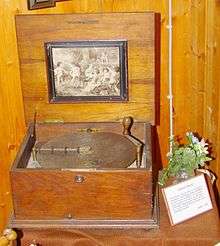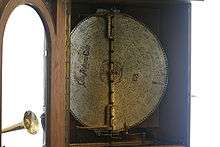Polyphon
Polyphon is a disc-playing music box, a mechanical device first manufactured by the Polyphon Musikwerke, located in Leipzig, Germany. Invented in 1870, full-scale production started around 1897 and continued into the early 1900s. Polyphons were exported all over world and music was supplied for the English, French and German markets, as well as further afield, with music cataloged for the Russian, Polish and Balkan regions. Polyphon is also a record label as registered by German Polyphon Musikwerke AG in 1908. Polyphon traded under the Polydor label since 1913 with their trademarks Polyphon Musik and Polyphon Record.[1]
| Polyphon | |
|---|---|
| Founded | 1887 |
| Distributor(s) | Self-distributed (worldwide) |
| Genre | Various |
| Country of origin | Germany |
| Location | Leipzig, Berlin |

Polyphon Musikwerke
The German company was founded in Wahren, Leipzig, as Firma Brachhausen & Riesener by Gustav Adolf Brachhausen and Ernst Paul Riessner in 1887 for manufacturing their new in 1870 invented mechanical disc-playing music box Polyphon.[2][3] The company was renamed to Polyphon-Musikwerke AG in 1895. Since 1908 Hugo Wünsch was director, but became head of the new subsidiary Deutsche Grammophon AG in 1918. Polyphon-Musikwerke AG acquired 24 April 1917 the record plant Deutsche Grammophon-Aktiengesellschaft from the German government. The German state was taken over DG and British holdings as enemies property during World War I. The factories Deutsche Grammophon and Polyphon-Musikwerke were handled by Polyphonwerke AG and headquarter was relocated in Berlin. The company was called Polyphon-Grammophon-Konzern.
In 1918 Polyphon AG established their head offices in Markgrafenstraße 76 in Berlin. Bruno Borchard became director general. The early owner Joseph Berliner remained as member of the boards until his retirement in 1921. In 1919 the Austrian subsidiary Polyphon-Sprechmaschinen und Schallplatten GmbH was founded in Vienna. It was as renamed Polyphon Schallplatten Ges. mbH. The Danish Nordisk Polyphon A. S. was founded in Kopenhagen. In Stockholm the Swedish subsidiary was called Nordisk Polyphon A. B. The ownership of foreign activities were concentrated in March 1929 into a Swiss holding company the Polyphon-Holding AG. In 1932 this holding was renamed to Polydor Holding AG.
The owner Polyphon Werke AG was merged with Deutsche Grammophon AG in 1932. Soon was the total shutdown of the production in Leipzig. In 1933 DG sold their shares of Polydor Holding. In 1937 DG was renamed to Deutsche Grammophon GmbH. A capital merger operation took place by a consortium of Deutsche Bank and Telefunken Gesellschaft. In 1932 founded Telefunken Platte GmbH got a production plant as it was needed. DGG was sold to the German Siemens & Halske AG electronics company in 1941. In 1954 DGG established a subsidiary in London, Polydor Records Ltd. In 2000 the French mediacompany Vivendi SA acquired the current owner Universal Music Group from Seagram.
Polyphon music box
Original examples still exist of 1870-invented Polyphon and contemporary manufacturers produce small quantities of both the devices and discs.

Making music
The tune is punched out on the disc with pitch determined by the position of the punching. In the manufacturing process, the punched metal was curled back onto the underside of the disc, creating a raised projection that resembles a letter P when viewed obliquely. When the Polyphon operates, the resulting disc projections, called plectra, engage with a series of ratchet-like star wheels, each with 9 projections, that sit in a gantry. Each star wheel, when moved through 40 degrees on its axis, plucks a tooth on the instrument's comb. The tooth resonates, sounding a predetermined note.
Upon the musical comb, the fast treble notes are sounded furthest from the centre and the slower base notes nearest the centre. Many comb variants were manufactured, including a single comb on smaller instruments, and duplex combs (simultaneous strike) on mid-sized examples of 11-inch-diameter and 15.5-inch-diameter instruments. Most larger twin-combed examples had alternate strike although other manufacturers, notably Symphonion, produced large size instruments with duplex combs.
Motor
Almost without exception, all Polyphons are powered by a hand-wound clockwork motor. Polyphon may have devised an electric motor variant of a large coin-operated model in the latter days of production, but to date, no known original examples exist. The motor has an output drive dog, which is a circular component with round-topped dowels arrange to fit the holes in the discs. Discs of small diameter have two centrally located holes (centre drive), while larger discs had a series of holes around the periphery (peripheral drive).
During operation, a disc is placed on the centre post, or centre boss, a pressure bar goes over the disc to hold it in place and the drive dog revolves the disc. The playing time for each disc varies, dependent upon the diameter. For example, the running time of a 19.5/8 inch-diameter disc (50cm) is about 1 minute and 50 seconds.
Modern availability
Numerous sizes of Polyphons and associated discs were produced, with the diameters ranging from 6 inches to 24.5 inches. It is possible to purchase new discs, currently manufactured in the UK by Renaissance Disc’s, for every size of Polyphon originally produced. Originals have survived in relatively large numbers, and are often available on internet sales sites.
Polyphon Musik
Polyphon disc records and machines followed in Germany 1905 and in England in June 1908. The trade mark was registered in Britain in 1900. Earlier Polyphon overstamped their place of origin. Polyphon as a label was founded in Leipzig on 8 September 1908 (registered Nr. 110347). In England their Klingsor Records label were repressed under Polyphon around 1910. In June 1913 the label was changed to Pilot.
Polydor label was founded 2 April 1913 in Leipzig and registered on 25 July 1914 (Nr. 316613). For example, Polyphon Musikwerke entered into Persian market in 1927. In 1927 Polyphon Musikwerke recorded 200 matrices in Iraq followed by making 600 recordings in Tehran. Their agent the Hakkak company opened shops in Baghdad, Tehran and Kermanshah. Polyphon Musik and Polyphon Record had unique issue series in 36 countries or areas within decades. In 1931 agreement with Polyphon gave for Decca exclusive British licence to records on this label.
Since 1946 Polydor has been the popular music arm, while the new Deutsche Grammophon Gesellschaft label was going to be a classical music label in 1949.[4] The previous used label Grammophon was disbanded.
References
Further reading
- Ord-Hume, Arthur W. J. G. (1973). Clockwork Music. London: Allen & Unwin. ISBN 978-0-04-789004-8.
